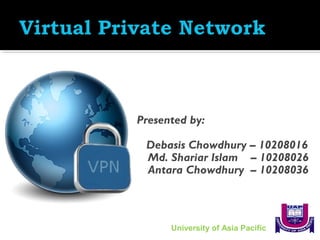Virtual Private Network (VPN).
- 1. Presented by: Debasis Chowdhury ¨C 10208016 Md. Shariar Islam ¨C 10208026 Antara Chowdhury ¨C 10208036 University of Asia Pacific
- 2. ? A technology that creates a network that is physically public, but virtually private.
- 3. Leased lines Leased lines Leased lines Leased lines
- 4. Virtual Private Networks (VPN) Basic Architecture
- 5. ? VIRTUAL . ? PRIVATE . ? NETWORK .
- 7. ?Tunneling is the process of placing an entire packet within another packet before it's transported over the Internet. ? That outer packet protects the contents from public view and ensures that the packet moves within a virtual tunnel.
- 9. ? Point-to-Point Tunneling Protocol (PPTP) ? Layer Two Tunneling Protocol (L2TP) ? Internet Protocol Security (IPsec)
- 10. ?Encryption is the process of encoding data so that only a computer with the right decoder will be able to read and use it. ? Used to convert data to a secret code for transmission over an trusted network Encryption Algorithm ˇ°The cow jumped over the moonˇ± ˇ°4hsd4e3mjvd3sd a1d38esdf2w4dˇ± Clear TextClear Text Encrypted TextEncrypted Text
- 11. ? For data encapsulation, VPN relies on either of the following technologies like GRE , IPSec, L2F,PPTP and L2TP . ? In which IPsec and PPTP are more popular.
- 13. ? Authentication process determine if the sender is the authorized person and if the data has been redirect or corrupted . ? There are 2 levels of Authentication. ? Computer-Level Authentication ? User-level Authentication
- 14. ? Firewall provides network security and business continuity . ? It prevents attacks, and secures your data communications with multiple parallel Virtual Private Network (VPN) connections. ? There are two approaches to using a firewall with a VPN server: ? VPN server in front of the firewall.. ? VPN server behind the firewall..
- 17. ? All traffic on the secure VPN must be encrypted and authenticated. ? The security properties of the VPN must be agreed to by all parties in the VPN. ? No one outside the VPN can affect the security properties of the VPN.
- 18. ? Remote access VPN ? Site to Site VPN
- 19. ? Provides access to internal corporate network over the Internet. ? Reduces long distance, modem bank, and technical support costs. InternetInternet Corporate Site
- 20. ? Connects multiple offices over Internet ? Reduces dependencies on frame relay and leased lines InternetInternet Branch Office Corporate Site
- 21. ? Site-to-Site VPN ? Extranet VPN ? Provides business partners access to critical information (leads, sales tools, etc) ? Reduces transaction and operational costs Corporate Site InternetInternet Partner #1 Partner #2
- 22. ? Site-to-Site VPN ? Intranet VPN: Links corporate headquarters, remote offices, and branch offices over a shared infrastructure using dedicated connections. InternetInternet LAN clients Database Server LAN clients with sensitive data
- 23. ? Security ? Reliability ? Cost Savings ? Expand Globally ? Easier ? No single point of failure ? Easier Network Management
- 24. ? Lower bandwidth available compared to dial-in line ? Inconsistent remote access performance due to changes in Internet connectivity ? No entrance into the network if the Internet connection is broken
Editor's Notes
- #8: A ˇ°tunnelˇ± is simply a link between two locations through some other material. A good analogy is a tunnel that goes under a mountain. Both sides of the mountain are linked up through a direct path; in this case the ˇ°mountainˇ± is the Internet. So essentially a tunnel is a direct shortcut through the Internet. LetˇŻs say you have a branch office in one location using a regular Internet connection and then you want to connect to a server somewhere at your main office location. Since the data you are transferring between offices is likely sensitive, you wouldnˇŻt want someone to be able to view that data while traveling over the Internet. That is where a VPN tunnel comes into play.

























